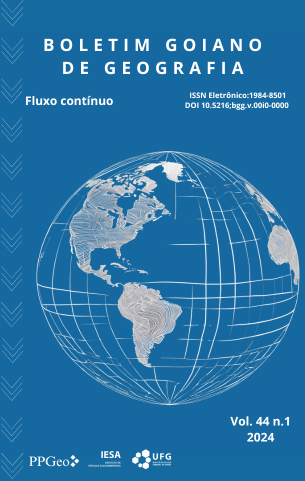PREDICTIVE MODELING OF OPTIMAL SITES FOR BIOGAS PLANT DEPLOYMENT IN SUGARCANE AGROINDUSTRIAL AREAS USING GEOGRAPHIC DATA AND ARTIFICIAL INTELLIGENCE
PREDICTIVE MODELING OF OPTIMAL SITES FOR BIOGAS PLANT DEPLOYMENT IN SUGARCANE AGROINDUSTRIAL AREAS USING GEOGRAPHIC DATA AND ARTIFICIAL INTELLIGENCE
DOI:
https://doi.org/10.5216/bgg.v44i1.77808Abstract
Aligned with the UN 2030 Agenda's imperative to facilitate the widespread adoption of renewable energies, this study underscores the pertinence of agricultural biomass, notably derived from sugarcane, as a substantive solution to Brazil's ongoing energy transition. The determination of optimal sites for the deployment of biogas plants is inherently contingent upon geographic considerations. This research advocates for the integration of geographic data with Artificial Intelligence algorithms, colloquially termed GeoIA, as a robust and prospective methodology for the precise anticipation of these optimal locations. In consideration of the foregoing, this study endeavors to forecast optimal sites for the implementation of sugarcane biogas plants within the agro-industry. Leveraging geographical data encompassing physical, biotic, and anthropic facets, alongside the employment of six distinct classification algorithms (CART, C4.5, C5.0, Random Forest, XGBoost, and GBM), performance comparison becomes paramount. The training phase specifically targeted the state of São Paulo, owing to its heightened concentration of plants, with the most efficacious model subsequently applied to the state of Goiás. The preeminent performance achieved by the Random Forest algorithm underscores its efficacy in delineating advantageous sites for the deployment of sugarcane biogas plants in Goiás. This methodological approach holds promise in streamlining decision-making processes, delineating regions conducive to biogas production from sugarcane, thereby optimizing biomass utilization and concurrently mitigating environmental impact and installation expenditures. The incorporation of GeoIA not only fosters the proliferation of renewable energies but also contributes substantively to climate change mitigation, thereby catalyzing the broader global energy transition.
Downloads
Downloads
Published
How to Cite
Issue
Section
License
Authors will not receive any payment for publishing their work in Boletim Goiano de Geografia. Therefore, they must grant all rights to the journal. However, they are entirely and exclusively responsible for the published contents, and editors are free to make corrections or adjustments to texts in conformity with publication guidelines.







